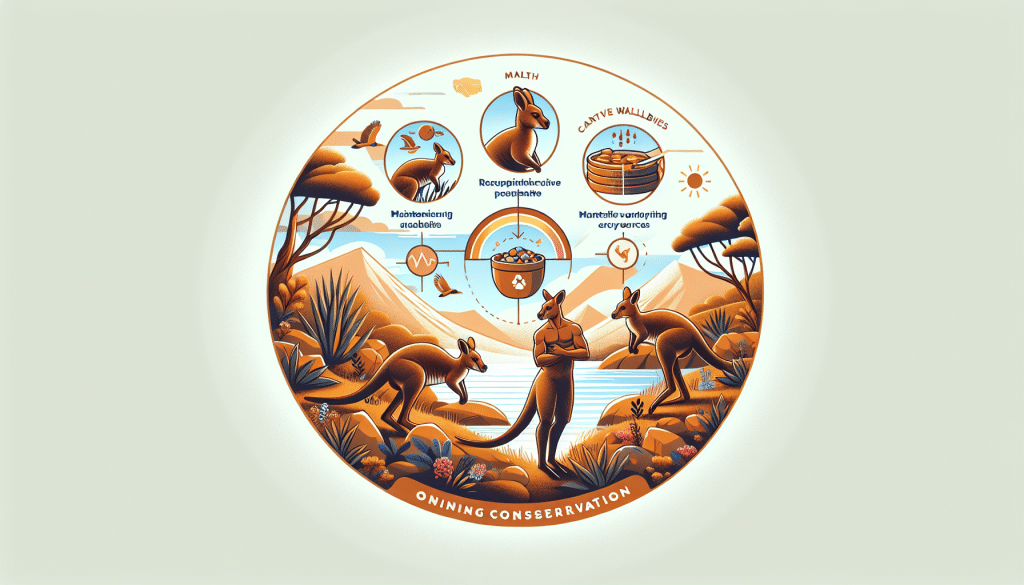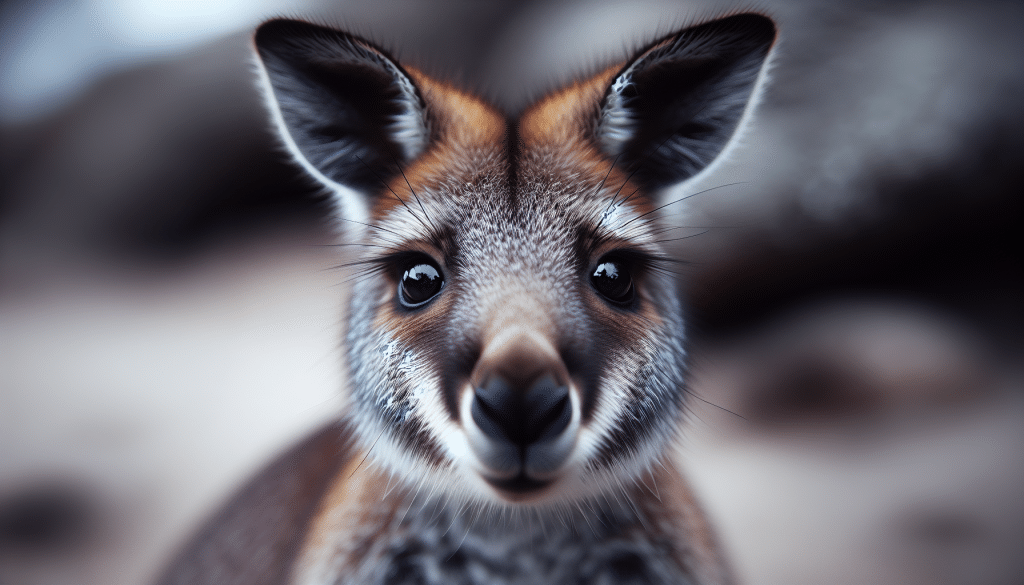Picture this: a group of wallabies, hopping and bounding through the lush green grass, their tails bouncing behind them with every joyful leap. They may seem carefree and content, but did you know that wallaby health and wellness are no laughing matter? These adorable creatures have unique needs and challenges when it comes to staying in tip-top shape. From maintaining a balanced diet to practicing self-care, the importance of wallaby health and wellness cannot be underestimated. Uncover the secrets to keeping these furry friends fit and thriving in the wild, and perhaps gain a newfound appreciation for the hidden world of wallaby wellness.

Understanding Wallaby Biology and Behavior
Physical characteristics of wallabies
Wallabies are small marsupials that belong to the kangaroo family. They have a compact body and long, powerful hind limbs, which enable them to hop with incredible speed and agility. On average, wallabies stand about 1 to 3 feet tall and can weigh anywhere between 10 to 50 pounds, depending on the species. They have a small head, big ears, and large, expressive eyes. Their fur can vary in color, ranging from shades of brown and gray to reddish and even albino.
Natural habitats and environmental needs
Wallabies are found in various parts of the world, particularly in Australia and surrounding regions. They inhabit a wide range of habitats, including forests, shrublands, grasslands, and even rocky areas. Wallabies are highly adaptable to different environments, although they generally prefer areas with access to fresh water sources and plenty of vegetation for grazing.
Social structure and behaviors
Wallabies are generally social animals and live in small groups known as mobs. These groups consist of several females, known as does, and one or two dominant males, known as bucks. Male wallabies will often engage in aggressive behaviors, such as fighting and boxing, to establish dominance and mating rights. Wallabies are mainly crepuscular, meaning they are most active during dawn and dusk. They spend their days resting in shaded areas to avoid the heat of the sun.
Diet and nutrition
Wallabies are herbivores with a diet primarily consisting of grasses, leaves, and other plant materials. They have a specialized digestive system that allows them to efficiently extract nutrients from fibrous plant matter. Wallabies are also known to practice coprophagy, which involves eating their own feces to obtain additional nutrients and maximize digestion. It may sound gross, but it’s a clever way for wallabies to get the most out of their diet!
Wallaby Health Concerns in the Wild
Common diseases and parasites
Like any wildlife species, wallabies are susceptible to various diseases and parasites. Some common health issues among wallabies include parasitic infections, respiratory diseases, and gastrointestinal disorders. Parasites, such as ticks, fleas, and worms, can cause discomfort and can even lead to severe health problems if left untreated.
Injury and predation
In the wild, wallabies face risks from predators such as dingoes, foxes, and large birds of prey. They can also sustain injuries from falls, fights with other wallabies, or encounters with vehicles. Additionally, habitat destruction and human encroachment have increased the risk of wallabies being hit by cars or facing other man-made threats.
Environmental stressors and climate change impact
Climate change and environmental stressors pose significant challenges to wallaby populations. Rising temperatures, altered rainfall patterns, and habitat loss can lead to decreased food availability, increased competition, and a higher risk of dehydration. These factors can weaken the overall health and resilience of wallaby populations, making them more vulnerable to diseases and other threats.
Conservation status and threats
Several wallaby species are currently listed as vulnerable, endangered, or critically endangered due to habitat destruction, poaching, and other human activities. Conservation efforts are crucial to ensure the survival of these unique marsupials and to protect their habitats from further degradation. By understanding their health needs and implementing effective conservation strategies, we can contribute to the preservation of wallaby populations for future generations to enjoy.

Captive Wallaby Health Management
Housing and enclosure requirements
Captive wallabies require appropriate housing and enclosures that mimic their natural habitat as closely as possible. The enclosure should offer ample space for exercise and grazing, as well as sheltered areas for resting and protection from extreme weather conditions. Fencing should be secure and provide adequate protection against predators.
Dietary needs and feeding schedules
Providing a well-balanced and nutritionally-rich diet is essential for the health of captive wallabies. Their diet should consist mainly of fresh grasses and leafy greens, supplemented with high-quality pellets specifically formulated for herbivorous marsupials. Feeding schedules should be consistent, and access to fresh water should always be available.
Mental stimulation and enrichment
Captive wallabies require mental stimulation and enrichment to prevent boredom and promote natural behaviors. Providing various toys, climbing structures, and opportunities for foraging can help keep them mentally and physically active. It’s important to rotate and change enrichment items regularly to keep the wallabies engaged and prevent habituation.
Preventative veterinary care
Regular check-ups with a qualified veterinarian are essential for monitoring the health and well-being of captive wallabies. Vaccinations and routine de-worming should be part of their preventative care plan. Medical examinations should be conducted if any signs of illness or injury are observed, and appropriate treatments should be administered promptly.
Reproduction and Breeding Health
Breeding cycles and mating behaviors
Wallabies have unique reproductive adaptations due to their marsupial nature. Female wallabies have a specialized two-vagina reproductive system and are capable of delayed implantation. This means they can pause their pregnancy until environmental conditions are more favorable for raising young. Mating behaviors often involve displays of dominance and courtship rituals, such as vocalizations and physical interactions between males and females.
Pouch health in females
Female wallabies have a pouch that provides a safe and nurturing environment for their joeys (baby wallabies). Proper pouch hygiene is crucial to prevent infections and ensure the healthy development of the joeys. Regular cleaning and monitoring for any signs of irritation or injury are essential.
Joey development and care
Wallaby joeys are born at a very premature stage of development and complete their growth inside their mother’s pouch. They rely on their mother’s milk for nourishment and gradually transition to a diet of grasses and other vegetation as they grow older. Caring for joeys involves regular monitoring of their growth, ensuring they are receiving adequate nutrition and providing the necessary mental and physical stimulation for their development.
Genetic diversity and breeding programs
Maintaining genetic diversity is vital for the long-term health and survival of captive wallaby populations. Breeding programs often employ careful genetic monitoring and pairing to prevent inbreeding and ensure the introduction of new genetic traits. These programs aim to create healthy and genetically robust populations that can potentially be reintroduced into the wild to support conservation efforts.

Nutrition and Diet
Essential nutrients for wallabies
Wallabies have specific nutritional needs to support their growth, reproduction, and overall health. They require a diet rich in fiber, protein, vitamins, and minerals. Key nutrients for wallabies include calcium, phosphorus, vitamin E, and copper, among others. A balanced diet that includes a variety of grasses, browse, and appropriate supplements is necessary to meet their nutritional requirements.
Supplementing diet for health
In some cases, additional supplements may be necessary to ensure wallabies are receiving all the essential nutrients they need. These supplements can include calcium and vitamin D3 powder sprinkled over their food, as well as specialized formulas designed to support the immune system or gut health. However, it’s crucial to consult with an experienced veterinarian or nutritionist to determine the appropriate supplementation for each individual wallaby.
Avoiding obesity and dietary diseases
Wallabies, like many herbivorous animals, are prone to obesity and dietary diseases if not provided with a balanced diet and appropriate portion sizes. Overfeeding or providing diets high in sugar or carbohydrates can lead to weight gain, dental issues, and digestive problems. Monitoring their body condition regularly and adjusting their diet as needed can help prevent these issues.
Feeding strategies for wild and captive wallabies
In the wild, wallabies graze on available vegetation, which provides them with a constant supply of fiber and nutrients. In captivity, their diet should mimic this natural grazing behavior as closely as possible. Providing access to fresh grasses and herbs, along with hay and other appropriate browse, allows captive wallabies to exhibit their natural feeding behaviors and ensures their nutritional needs are met.
Veterinary Care for Wallabies
Routine check-ups
Regular veterinary check-ups are essential to monitor wallaby health and detect any potential issues early on. During routine check-ups, the veterinarian will assess overall body condition, dental health, and listen to heart and lung sounds. They may also conduct tests to evaluate blood parameters and screen for any signs of infection or underlying health conditions.
Vaccination and de-worming
Vaccinations and de-worming protocols should be established and administered according to the veterinarian’s recommendations. These measures help protect wallabies from common diseases and parasitic infections that can have detrimental effects on their health and well-being. Following appropriate vaccination and de-worming schedules is crucial for maintaining the overall health of captive wallabies.
Diagnostics and treatments
When health issues arise, thorough diagnostics and appropriate treatments are necessary to address the problems effectively. Depending on the symptoms or suspected underlying causes, diagnostic procedures may include blood tests, radiographs, ultrasound scans, or even more specialized tests. Once a diagnosis is established, treatments can range from medications and surgeries to supportive care and rehabilitation.
Emergency care and trauma management
Accidents and emergencies can happen, even in the most well-managed captive environments. It’s crucial to have emergency protocols in place and a trusted veterinarian on call for immediate care. Trauma management may involve stabilizing the wallaby, providing pain relief, and addressing any wounds or fractures as quickly as possible to minimize further harm and increase the chances of a successful recovery.
Psychological Well-being and Stress Reduction
Signs of stress and anxiety in wallabies
Stress can have a significant impact on the health and well-being of wallabies, both in the wild and in captivity. Some signs of stress and anxiety in wallabies include excessive vocalizations, aggressive behaviors, loss of appetite, excessive grooming, and self-mutilation. Observing their behavior and identifying potential stressors can help mitigate these issues and improve their overall psychological well-being.
Environmental enrichment practices
Providing a stimulating and enriching environment is crucial for promoting positive mental health in wallabies. Enrichment can include the introduction of new toys, puzzle feeders, hiding spots, and scent trails. Incorporating elements of their natural habitat, such as trees or artificial climbing structures, allows wallabies to engage in their natural behaviors and helps alleviate stress and boredom.
Social interaction and its effects on mental health
Wallabies are social animals and require appropriate social interaction to thrive. In captivity, this can be achieved by housing compatible individuals together or allowing controlled supervised interactions. Social companionship can reduce stress, promote mental stimulation, and improve overall well-being. However, it’s important to monitor their interactions closely to prevent aggression or dominance issues.
Handling and human interaction
Proper handling and minimal human interaction are key to reducing stress in captive wallabies. Wallabies are not domesticated animals and may perceive human contact as a potential threat. Caretakers should follow gentle handling techniques, respect the wallabies’ personal space, and minimize direct contact unless necessary for health assessments or medical treatments.
Exercise and Physical Activity
Importance of movement for physical health
Physical exercise is vital for the overall health and well-being of wallabies. Regular movement helps maintain muscle strength, cardiovascular fitness, and joint flexibility. It also stimulates natural behaviors and prevents the development of obesity-related health issues.
Designing enclosure with ample space for exercise
Captive wallabies require enclosures that provide ample space for them to move, hop, and run around. The enclosure should be designed with different levels, slopes, and obstacles to encourage natural exploratory behaviors and provide opportunities for exercise.
Creative exercise routines
Engaging wallabies in creative exercise routines can prevent boredom and help maintain their interest in physical activity. This can include creating obstacle courses, offering puzzle feeders, or introducing new toys that require movement and manipulation. Rotating and varying these exercise routines will help keep wallabies mentally and physically stimulated.
Monitoring physical condition and mobility
Regularly assessing the physical condition and mobility of wallabies is essential to ensure they are maintaining a healthy weight and fitness level. Monitoring weight, observing the ease of movement, and checking for any signs of stiffness or lameness can help detect subtle changes in their physical well-being and allow for early intervention if necessary.
Disease Prevention and Control
Biosecurity measures for populations
In captive environments, implementing biosecurity measures is crucial to prevent the introduction and spread of diseases. This can include strict quarantine protocols for new arrivals, limiting exposure to outside wildlife, and maintaining good hygiene practices. Regular health screenings and monitoring are necessary to detect any signs of potential disease outbreaks and allow for timely intervention.
Quarantine and monitoring of new arrivals
New arrivals to captive wallaby populations should undergo a strict quarantine period to minimize the risk of introducing infectious diseases. During this period, the wallaby should be kept separate from other individuals, and regular health checks should be conducted to ensure they are healthy and free from any potential pathogens.
Regular health screenings
Regular health screenings, including physical examinations, blood tests, and fecal exams, should be conducted as part of routine health monitoring. These screenings can help detect hidden infections, internal parasites, or any signs of illness or abnormality before they become more severe.
Outbreak management protocols
Despite proactive measures, outbreaks of diseases can still occur in captive wallaby populations. In such cases, it’s important to have outbreak management protocols in place to quickly identify affected individuals, isolate them, and implement appropriate treatment and prevention measures to contain the spread of the disease and minimize its impact on the overall population.
Future Challenges in Wallaby Health and Conservation
Adapting to changing climates
Climate change poses significant challenges to wallaby health and conservation efforts. Rising temperatures, altered rainfall patterns, and habitat loss due to extreme weather events can disrupt natural ecosystems and impact the availability of food and water sources. Developing adaptive strategies and habitat preservation plans will be crucial for mitigating the effects of climate change on wallaby populations.
Genetic research and biodiversity
Understanding the genetic diversity of wallaby populations is essential for conservation efforts. Genetic research can help identify genetically distinct populations and determine their vulnerability to potential threats. This information can then be used to develop breeding programs aimed at preserving genetic diversity and mitigating the risk of inbreeding.
Human-wildlife conflict
As human populations expand, conflicts between humans and wallabies can escalate. Wallabies may venture into agricultural areas, causing damage to crops or becoming victims of road accidents. Developing strategies to promote coexistence, such as the use of wildlife corridors, implementing non-lethal deterrents, and raising public awareness, will be crucial to reduce human-wildlife conflicts.
Conservation strategies and policy development
Effective conservation strategies and policy development are vital for ensuring the long-term survival of wallabies. This includes habitat preservation, strict regulations against poaching, and the implementation of captive breeding programs. Collaborative efforts between government agencies, conservation organizations, researchers, and local communities are crucial for developing and implementing these strategies.
In conclusion, understanding wallaby biology, behavior, and health needs is imperative for their well-being and conservation. By addressing their physical, psychological, and nutritional needs, we can help ensure the long-term survival and thriving populations of these remarkable marsupials. Through responsible management of wild populations and proper care and husbandry in captivity, we can contribute to the preservation of wallabies for future generations to enjoy their unique beauty.


